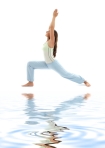So why bother talking very much about alignment, except in teacher training? I mean, obviously teachers should know something about alignment, but do we really need or want to interrupt the flow of class with it?
Yes! As a teacher, I attach great importance to speaking poetically about alignment and bringing out the metaphor of aligning with our inner truths, even exploring the duality that the concept implies. Alignment is absolutely the core teaching of, in and about yoga pose, because without attention to alignment of joints, planes and limbs, the poses only reinforce the very habits – samskara – we are in yoga class to unravel, unknot and unlive. In the absence of attention to alignment, we are not only unsafe mechanically, but we are grinding the grooves of our habitual responses ever deeper.
Let’s look at a simple pose, like Virabhadrasana, Warrior I. One foot forward, one back, hips square to small edge of mat, arms up. Simple, right? Simple, but not easy.
The back leg reaching back has a tendency to fall, bend at the knee and generally “hang out”. When we energize and straighten it by engaging the muscles 360 degrees to center, what happens in the pelvis? The hamstrings and the hip flexors – iliopsoas – are opposing one another. By engaging that back leg, we tug the hip flexors, which sounds great, right – stretch is good. But what are we likely stretching?More likely, we’re stretching the abs, not keeping the core engaged, compressing the low back and simply tugging the front of the pelvis down a bit. Why, How? The back femer, reaching back, brings with it the attachment of the hip flexor, which stretches as much as it can. Cool. But it’s a deep and not easily sensed muscle. What happens when it gets to it’s maximum? it tugs on the interior of the pelvis, the next place where muscle meets bone. Hmmm. There’s another section that crosses to the spine, and this is in turn stretched by the pelvis careening forward, but only to its limit. Beyond that, the belly pooches and the tailbone comes up. The low back in between gets crunched like a sandwich in a brown bag at the bottom of your backpack. Ouch.
And this is probably a familiar progression if you do any office work or driving at all, because the hip flexor is in it’s relatively contracted position for long periods of time. This is familiar, this is habit. This is what we’re here to bring attention to. And alignment allows us to do so.
What if you felt the alignment of your ribcage and pelvis in Mountain – the pose that looks suspicously like just standing there only with great attention – with a neutral pelvis by placing your thumbs at the bottom of your ribcage and your fingertips on the top of your hip bones. Now, step back into Virabhadrasana I, back foot turned at about 45 degrees, keeping the same alignment between hips and ribcage. Quite a revelation, huh? Notice where you feel engagement to preserve your alignment. Notice where you are tempted to fly out of alignment for the “look” of the pose.
Alignment is everything because awareness is everything. Whether you understand it from technical anatomical terms or from putting your hands on your ribs and hips to feel when they move, the awareness is what yoga is all about. Without it, you’re a Rhinestone Warrior.





















